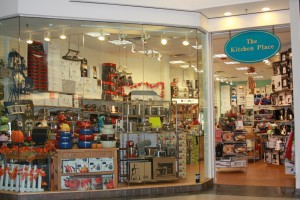Courting the Millennial Dollar In Its Natural Habitat
By Micah Cheek
In an era when big box stores are driving kitchenware retailers out of the malls and onto the street, Pam Sullivan of The Kitchen Place is making the mall work for her.
 Sullivan currently has two The Kitchen Place locations: One in the Solomon Pond Mall in Marlboro, Massachusetts, and one in the Rockingham Park Mall in Salem, New Hampshire. Even though both of these locations are at odds with the kitchenware departments of JC Penney’s, Macy’s and Bed Bath & Beyond, her business is still thriving. Part of the credit goes to the mall being a natural haven for Millennial buyers. These younger customers, on their way to stores like Gamestop, Torrid and The Apple Store are pulled in by a vibrant, 12-foot gadget wall that lines each of Sullivan’s stores.
Sullivan currently has two The Kitchen Place locations: One in the Solomon Pond Mall in Marlboro, Massachusetts, and one in the Rockingham Park Mall in Salem, New Hampshire. Even though both of these locations are at odds with the kitchenware departments of JC Penney’s, Macy’s and Bed Bath & Beyond, her business is still thriving. Part of the credit goes to the mall being a natural haven for Millennial buyers. These younger customers, on their way to stores like Gamestop, Torrid and The Apple Store are pulled in by a vibrant, 12-foot gadget wall that lines each of Sullivan’s stores.
As with many other kitchenware retailers, courting the Millennial crowd has become a necessity. “We had been [selling to] baby boomers, they were great customers,” says Sullivan. Now, she notes, the Baby Boomers have acquired all the kitchenware and appliances they need, and only come in to buy gifts for others. Sullivan has responded to this by shifting her inventory to match Millennial needs. “Boomers are all over my brand cookware,” says Sullivan. “Not so much with Millennials.” The younger generation has tended to buy based on quality rather than brand, because of the constraints of lower disposable income. “They want to see that they can get something for less money, but in their eyes is as good as Brand X,” says Sullivan. Sullivan has sold to this demographic successfully by helping these customers compare brands, helping them find products that are nearly equivalent to a leading brand, at a more reasonable price.
For Sullivan, competing with big box stores in the mall is a matter of expertise. While JC Penny’s and Bed Bath & Beyond have kitchenware departments, they do not carry the same level of experience and wealth of information The Kitchen Place provides. This especially comes in handy with customers that are price checking before coming into the store. “They’ll tell you they found it cheaper online. You have to address it. I’ve found that in this instance, if it’s a lot cheaper something’s wrong.” says Sullivan. She recently confronted this issue with a customer remarking about how inexpensive her newest knife was online. Sullivan let the woman test the model she thought she had bought, and “Her jaw dropped,” says Sullivan. “She got a good deal on it, she was happy until she came into the store, then she realized she got a cheaper stamped knife.” Keeping her staff abreast of products and trends is an essential part of looking credible among so many other shopping options. “It’s about knowledgeable staff,” says Sullivan. “These trade magazines are great for that, lots of great information.” In fact, Sullivan makes a point of working with her 14 staff members to assure she has informed employees in her stores. “Each store seems to have one employee that comes and goes. One’s a musician, I can lose her for 4 or 5 months at a time,” says Sullivan. “But you’ll do that when you have really good employees.”
The advertising structure afforded by being a mall tenant has proven to be a great benefit. “I can always do things with the mall and their advertising, and piggyback on there,” says Sullivan. “The mall has thousands of followers on their email. When we’re doing our specials, I can put that up on their sites.” The marketing avenue the malls provide also helps to sidestep the marketing efforts of online shopping companies. The mall’s website helps The Kitchen Place inform customers without directing them to an online retailer, like a search engine would. This is worth doing because, as Sullivan notes, Google and other search engines will prioritize searches for certain companies as a service. “It’s Amazon, It’s Bed Bath & Beyond, or whoever is paying to be brought up.”
The resurgence of home entertaining has given a great boost to The Kitchen Place’s business in knives. Not only are consumers investing in good knives for their own use, but more are bringing high-end knives to parties and occasions where cooking will be involved. “We talk to a lot of people this time of year, they do things as a group and bring their own knives,” says Sullivan. “[They say,] ‘I want to bring them a knife, I want to show them what a good knife is.’” By matching knife promotions with mall shopping events, Sullivan has been able to attract customers with appealing prices. Companies like WUSHTOF have been engaging in aggressive promotional campaigns, lowering prices to increase brand awareness. Sullivan adds, “We in turn lower the pricing, and we’re still making a decent margin on it.”

You must be logged in to post a comment.